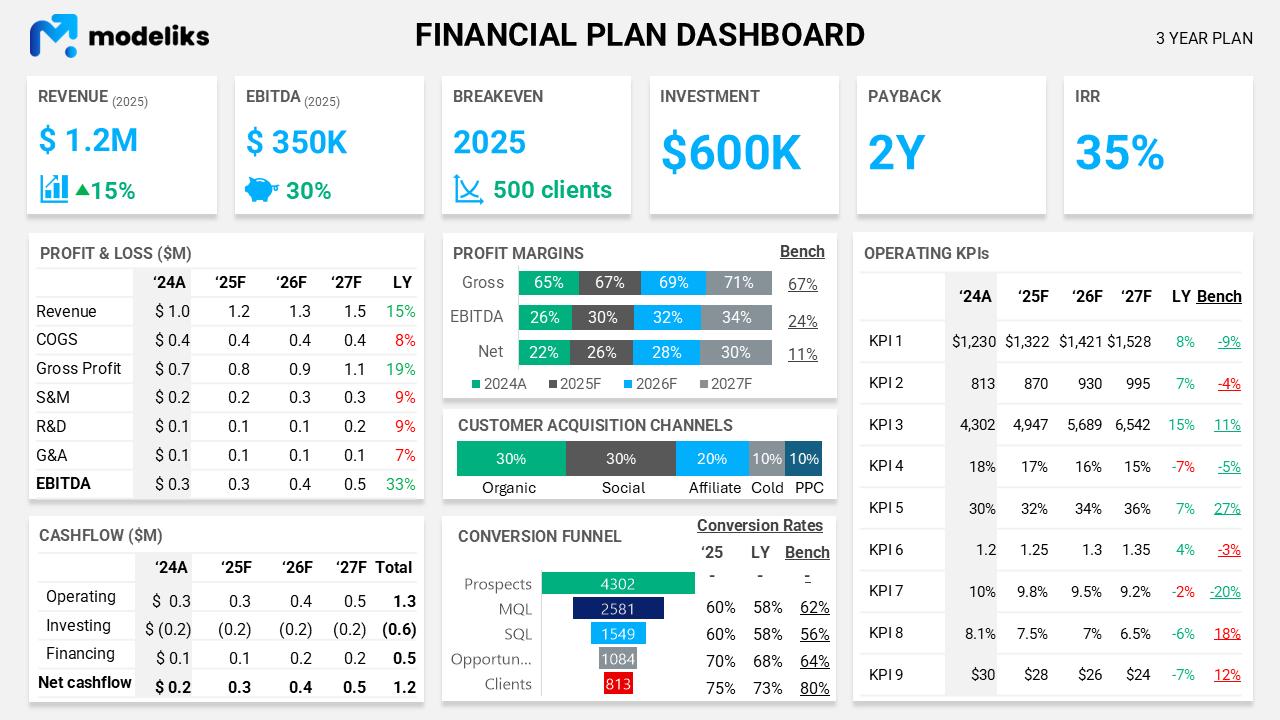Our DJ and Music Entertainment Financial Model Structure covers all the essential aspects you need to consider when starting or scaling a DJ and Music Entertainment business. By following this structure, you can better understand your revenue streams, costs, and assets, helping you optimize profitability and strategically plan for growth.
Financial planning for a DJ and Music Entertainment business is essential for its long-term success. Understanding and crafting a comprehensive DJ and Music Entertainment financial model can illuminate typical revenues, direct costs, employee roles, and necessary assets; thus, it provides insights into new, lucrative revenue streams. Such a model serves as a vital tool as you launch or expand your business, helping to anticipate financial requirements and identify potential growth opportunities.
The DJ and Music Entertainment Financial Model Structure
This DJ and Music Entertainment financial model emphasizes common revenue streams, associated costs, required staff, operating expenses, and necessary assets, along with potential funding options. However, creating this model is not without its challenges, but it remains indispensable for navigating the complexities of the industry.
Revenues
- Performance Fees: Calculated based on the number of gigs and the average rate per gig.
- Merchandise Sales: Revenue derived from the number of units sold multiplied by the price per unit.
- Music Sales and Streaming: Depend on how many tracks are sold or streamed and the rate per sale or stream.
- Sponsorships and Partnerships: Negotiated amounts with brands for promoting their products or services.
- Workshops and Masterclasses: Revenue calculated from the number of attendees and the fee per attendee.
- Event Hosting: Charges per event organized, based on size and complexity.
- Licensing and Royalties: Agreements for using original music in various media, which can vary significantly.
Cost of Goods Sold
- Equipment Rental Costs: Fees incurred for renting DJ equipment and sound systems are significant.
- Product Costs for Merchandise: Cost of materials, production, and packaging can also add up.
- Licensing Fees: Payments for using copyrighted music tracks must not be overlooked.
- Staff and Event Costs: Payments to crew and assistants involved in performances and events.
- Travel and Accommodation Costs: Expenses incurred when traveling for gigs or events can be a considerable burden.
Employees
- DJ: Responsible for music selection, mixing tracks, and engaging the audience.
- Sound Technician: Ensures the equipment functions properly and sound quality is maintained.
- Event Manager: Plans and organizes events, coordinating logistics and staffing requirements.
- Marketing Manager: Develops and implements promotional strategies to build brand awareness.
- Sales Manager: Handles client communications and sales of performances and merchandise.
Operating Expenses
- Marketing and Advertising: Expenses incurred when promoting events, new releases, and brand campaigns.
- Venue Hire Fees: Charges associated with renting locations for hosting events.
- Transport Costs: Expenditures related to logistics and transport needs for events.
- Insurance: Premiums required for liability and equipment coverage, essential to address accidents and damages.
- Utilities: Expenses for electricity, water, and internet, crucial for running an office or studio.
- Repairs and Maintenance: Costs incurred for upkeep and repairs of equipment and vehicles.
- Professional Fees: Legal, accounting, and consultancy payments that ensure compliance.
- Licensing and Compliance: Fees needed for obtaining necessary permits and licenses.
- Subscription Fees: Charges for memberships and subscriptions to industry-specific software and services.
- Office Supplies: General supplies used in business operations.
Assets
- DJ Equipment: Includes high-quality sound systems, mixers, and turntables, essential for any event.
- Vehicles: Necessary for transporting equipment and personnel to events.
- Office or Studio Space: Utilized for administrative tasks, meetings, or music production.
- Merchandise Inventory: Stock of items such as T-shirts, hats, and posters, requiring careful management.
Funding Options
- Personal Savings: Using personal funds to finance the start of your business can be effective.
- Bank Loans: Requires securing loans from financial institutions by presenting a strong business plan.
- Angel Investors: Involve attracting individuals willing to invest in exchange for equity.
- Crowdfunding: Raising funds through online platforms, appealing to the public.
- Grants and Competitions: Offers additional funding opportunities, including applying for industry-specific grants or participating in contests.
Driver-based Financial Model for DJ and Music Entertainment
A professional financial model for a DJ and Music Entertainment business centers on operating KPIs that drive performance. DJ and Music Entertainment financial model focuses on crucial operational elements .
- The number of gigs booked indicates the total number of performances secured over a given period.
- Average ticket price, impacts total revenue substantially.
- The merchandise conversion rate reflects the percentage of audiences that purchase merchandise at events.
- Stream count, which tracks the number of times music is streamed online, plays a significant role in measuring success.
- Social media engagement measures interaction levels on social platforms, crucial for building a brand.
- Client acquisition cost, the cost associated with acquiring each new client or gig, is essential.
- Equipment utilization rate, the frequency of equipment use relative to downtime, also plays a crucial role.
Driver-based financial planning involves identifying activities that have the greatest impact on business results, building financial plans around those drivers, and establishing relationships between financial outcomes and required resources. If you want to know more about driver-based financial planning and why it is the right way to plan, see the founder of Modeliks explaining it in the video below.
Need a financial model?
Create one with Modeliks and be confident in your numbers!
Manage & Grow with us!
The Financial Plan Output
The purpose of financial forecast outputs is to enable you, your management, board, or investors to quickly comprehend how your DJ and Music Entertainment business will perform in the future. You will gain reassurance that the plan is well thought out, realistic, and achievable. Moreover, you must understand what investment is necessary to implement this plan and what the return on the investment will be. To accomplish these goals, here is a one-page template on how to effectively present your financial plan.

Aside from this one-page summary, you will require three projected financial statements:
- Profit and Loss
- Balance Sheet
- Cash Flow Statement
DJ and Music Entertainment Financial Model Summary
A professional DJ and Music Entertainment financial model will help you assess your business, pinpoint necessary resources to meet targets, set goals, and measure performance. This will secure funding and make informed decisions to manage and expand your enterprise. However, because it provides clarity, it is essential for growth. Although it may seem daunting, the benefits are substantial.
If you need help with your financial plan, try Modeliks , a financial planning solution for SMEs and startups or contact us at contact@modeliks.com and we can help.
Author:
Blagoja Hamamdjiev
, Founder and CEO of
Modeliks
, Entrepreneur, and business planning expert.
In the last 20 years, he helped everything from startups to multi-billion-dollar conglomerates plan, manage, fundraise, and grow.

TAKE MODELIKS FOR A SPIN
Not sure which plan?
Start with a 15 days free trial.
You will have access to the full functionality of Modeliks. The only restriction in the free trial is that you cannot download or share your business plan outside Modeliks. Credit card is not required to subscribe for the free trial.





